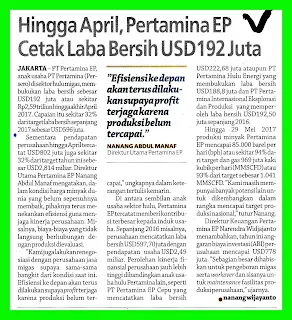The subsidiary of PT Pertamina, PT Pertamina EP, posted a net profit of US $ 192 million or equivalent to Rp2.59 trillion (exchange rate 13,500) until the end of April 2017. That number reaches 32% of its net profit target of 2017
US $ 596 million.
Pertamina EP president director Nanang Abdul Manaf said the company's revenue up to April also increased 32 percent from this year's target. This year's target is set at US $ 2.814 billion, but Pertamina EP only records US $ 802 million.
"If production does not go up, we have to increase efficiency in order to keep the profit good," said Nanang in a written statement in Jakarta yesterday.
According to Nanang, efficiency is continuously done and costs are not directly related to production in the evaluation. It contributes to the achievement of net income. Not only that, the operational efficiency is done by renegotiating contracts with oil and gas service companies.
"We are doing renegotiation, so that both will rise from the current conditions. Activities that will continue to be done in the future so that the profit is maintained because the production has not been achieved, "
Until May 29, 2017, Pertamina EP oil production reached 85 thousand barrels per day or about 94% and 969 million cubic feet per day (mmscfd) or 93% of the target of 1,041 mmscfd. Realization was claimed to almost reach the target that has been declared. However, some drilling results by the end of 2016 have not shown results like the original projection.
"We still have many other potentials to be developed in order to achieve national production targets," he said.
Nanang also explained, broadly the entire field fluctuate with a stable tendency in the range of production target numbers. At present, the target is from Pertamina EP Asset 4.
To achieve production and lifting targets in accordance with RKAP is to accelerate and add RK both drill, workover, and well intervention, as well as improving the quality of candidate wells or the implementation process of his work, then accelerate the process of PSE and the preparation of POD well exploration
Until the end of May 2017 there are six development projects in Pertamina EP work area, among others Paku Gajah Development Project in South Sumatra and Matindok Gas Development Project in Central Sulawesi.
IN INDONESIAN
Pertamina EP Bukukan Laba Rp 2,5 Triliun
Anak usaha PT Pertamina, PT Pertamina EP, membukukan laba bersih sebesar US$192 juta atau setara Rp2,59 triliun (kurs 13.500) hingga akhir April 2017. Angka itu mencapai 32% dari target laba bersih sepanjang 2017 yang sebesar
US$596 juta.
Direktur Utama Pertamina EP Nanang Abdul Manaf mengatakan pendapatan perusahaan hingga April juga tercatat mengalami peningkatan 32% dari target tahun ini. Target tahun ini ditetapkan US$2,814 miliar, tetapi Pertamina EP hanya mencatat US$802 juta.
“Kalau produksi tidak naik, kita harus makin giat efisiensi agar profit tetap bagus,” kata Nanang dalam keterangan tertulisnya di Jakarta, kemarin.
Menurut Nanang, efisiensi terus dilakukan dan biaya-biaya yang tidak langsung berhubungan dengan produksi di evaluasi. Hal itu yang berkontribusi dalam pencapaian laba bersih. Tidak hanya itu, efisiensi dari sisi operasional dilakukan yakni dengan melakukan renegosiasi kontrak dengan perusahaan jasa migas.
“Kami lakukan renegosiasi, agar sama-sama bangkit dari kondisi saat ini. Kegiatan itu ke depan akan terus dilakukan agar profit terjaga karena produksi belum tercapai,”
Hingga 29 Mei 2017, produksi minyak Pertamina EP mencapai 85 ribu barel per hari atau sekitar 94% dan gas 969 juta kaki kubik per hari (mmscfd) atau 93% dari target sebesar 1.041 mmscfd. Realisasi itu diklaimnya hampir mencapai target yang sudah dicanangkan. Namun, hasil beberapa pengeboran di akhir 2016 belum menunjukkan hasil seperti proyeksi di awal.
“Kami masih mempunyai banyak potensi lain untuk dikembangkan dalam rangka mencapai target produksi nasional,” ucap dia.
Nanang juga menjelaskan, secara garis besar seluruh lapangan fluktuatif dengan kecenderungan stabil pada kisaran angka target produksi. Saat ini yang sudah mencapai target ialah dari Pertamina EP Asset 4.
Untuk mencapai target produksi dan lifting sesuai dengan RKAP ialah dengan percepatan dan penambahan RK baik bor, workover, maupun well intervention, serta peningkatan kualitas kandidat sumur ataupun proses pelaksanaan pekerjaannya, kemudian melakukan percepatan proses PSE dan penyusunan POD sumur eksplorasi
Hingga akhir Mei 2017 terdapat enam proyek pengembangan di wilayah kerja Pertamina EP, antara lain Paku Gajah Development Project di Sumsel Serta Matindok Gas Development Project di Sulawesi Tengah.
Media Indonesia, Page-18, Monday, June 5, 2017









